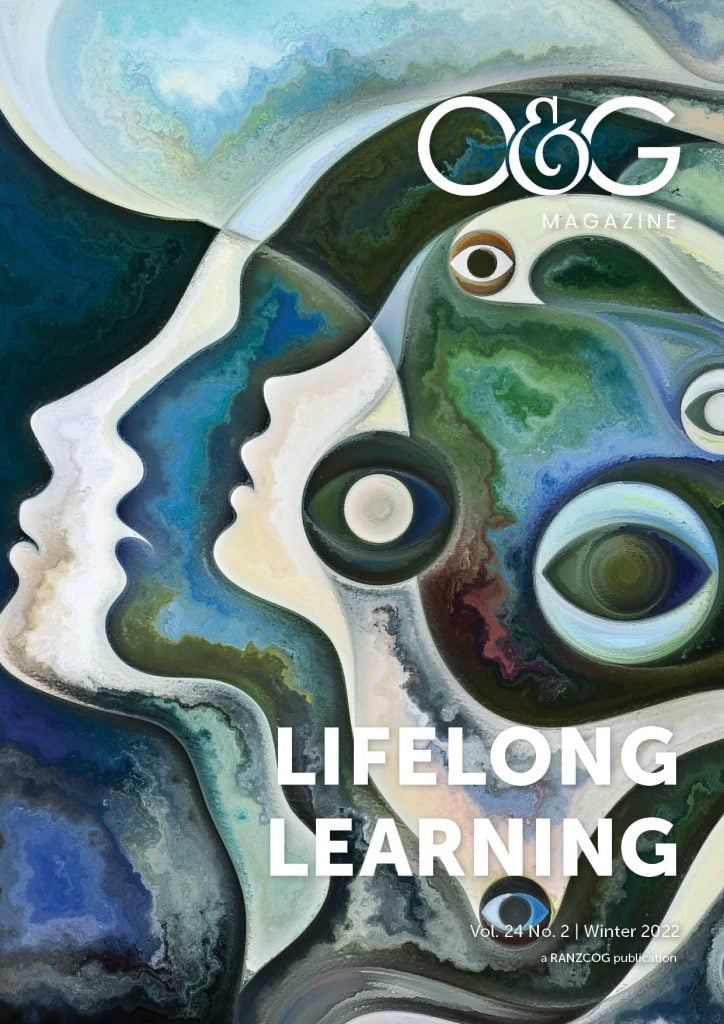One of the highlights of the triennial FIGO World Congress in Vancouver back in 2015 was voting for the city to host the 2021 Congress. The RANZCOG bid had taken shape years before and all of us present at the meeting were overwhelmed with excitement, and trepidation. The College bid was ultimately successful and Sydney was set to host what promised to be one of the great women’s health meetings of the world.
It turned out that the bidding process that won us the privilege to hold FIGO 2021 in Sydney was just the beginning. It is difficult to describe the amount of work that went into preparing for the meeting. Running a meeting for an anticipated 8000 delegates from almost every country in the world is no easy task. College staff and an army of volunteers expended an enormous amount of time and energy shaping what had the potential to be a flagship meeting for our speciality. All seemed to be going well until the beginning of 2020 and the first wave of COVID-19 infections in Australia.
The emergence of COVID-19 has had a profound effect on medical and other scientific conferences. Analyses have reported that by the second half of 2020, almost half of all conferences had been cancelled and 75% of the remainder were postponed.1 When conferences did eventually run, about 70% were in a fully virtual format, with the majority shortened. The flagship journal Nature first addressed the effects of the pandemic in March of 2020:
As the coronavirus pandemic marches around the world, leading to unprecedented measures to stop the virus’s spread, the number of scientific conferences being cancelled is rising and researchers are scrambling to find alternative ways to share their work and interact with collaborators. Some of these discussions are even pushing researchers to rethink the concept of meetings entirely: what is the point of a conference now?2
A year later, Nature was sizing up the future after a year of disruption to scientific meetings:
Although researchers are getting ‘Zoom fatigue’ just like everyone else, they’ve learnt to appreciate virtual science conferences during the COVID-19 pandemic, according to a poll of more than 900 Nature readers. After navigating a year of online research presentations, the majority of survey respondents (74%) think that scientific meetings should continue to be virtual, or have a virtual component, after the pandemic ends. Readers cite the ease of attending from anywhere in the world as a major perk, although they admit that virtual events haven’t been able to simulate the networking with colleagues they enjoyed in person.3
Medical conferences have a broad social impact. Not only do they foster research and education, but other key outcomes include policy development, career and personal skill development, as well as marketing of new technologies and equipment. Of course, interactions with colleagues at the meeting itself and associated social events are important. It is also worth remembering that ‘in addition, national meetings act as major drivers of regional economies for a host city because the meeting ‘community’ encompasses meeting planners, attendees, convention centres, hotels, restaurants, transportation, and more.’4
Medical conferences evolved before the current era of global connectivity, in a time when it was necessary to travel to present ideas to, and connect with, your peers. It is now clear that there are also well-recognised negatives of in-person conferences and meetings. It has been estimated that a typical four-day conference with 1000 attendees generates about 3000 tonnes of CO2 emissions.5
As a recent blog post from the BMJ put it:
While international medical conferences represent a major industry, they come with an excessive carbon footprint. Conference organisers therefore have a duty to make them both more sustainable and ecologically responsible. The impact of conference travel is little appreciated or researched, but one study has shown that attending a 2.5 day conference increases an individual’s carbon footprint by more than 6.7 times the normal EU daily level of production.6
Despite commendable optimism about the direction of the pandemic, it became clear that it would not be possible to hold an in-person FIGO congress in Sydney, and the difficult decision was made to change to a virtual meeting format. Having been involved in the successful campaign to bring the world congress to Australian shores for almost a decade, and having devoted hundreds and hundreds of hours to preparations, I found this a heartbreaking decision. It was, however, the correct decision: at the time FIGO was scheduled to run, Sydney was battling a prolonged and devastating outbreak of the COVID delta variant. An in-person conference would have been a disaster. Converting to a virtual format allowed the organising team – both in Australia and the international FIGO committees – to deliver a great online meeting with enormous global reach.
It is now clear that virtual and hybrid meetings are the future. The pandemic crisis has given us pause to reimagine what a conference is and what such meetings can deliver for their participants. The technology at our disposal to deliver a virtual meeting has advanced rapidly and allows a real-time, high-quality experience for those present. Virtual events reduce travel and allow participants who might not be able to attend an in-person event – either because of cost, geography, or both – to be present and engaged. Interactive chat and Q&A tools foster interaction: indeed, people who might feel inhibited about asking questions at a live microphone in a lecture hall often have no issues with posting their questions or comments online. Sessions can be recorded and watched at leisure, or repeatedly, as desired.
There also are a number of important negative aspects to virtual meetings. Everyone has experienced ‘Zoom fatigue’ and it is difficult to spend lengthy periods in front of a personal computer. Similarly, when participants are joining from their home, hospital or office, they commonly multitask and complete other work or home tasks at the same time, drawing their attention away from the meeting. Many conferences feature workshops and practical sessions that are well attended. These are difficult to provide in a virtual setting; however, there is now enormous incentive for development of virtual reality simulation systems that can be delivered allowing for remote teaching and even assessment. These virtual reality practical sessions are likely to become de rigueur for medical and scientific meetings in the very near future.
There is no way that conferences that exist in a purely online environment can replicate the experience of in-person meetings, with the opportunities they provide to strengthen personal relationships and networks. For this reason, and despite the environmental advantages of conferences existing in a virtual setting, hybrid meetings – with a combination of a physical meeting with strong virtual component – are likely to become the accepted standard in the very near future. Key speakers who are unable to travel can speak and take questions remotely. Issues of affordability, equity, and accessibility for potential participants are neatly dealt with. This democratisation of learning will overcome physical and other borders, aiding the dissemination of knowledge.
The pandemic has had a transformational effect on medical education across the globe. All aspects of education – from medical schools to vocational training, and ongoing professional development for clinicians – have been profoundly affected.7 One of the major sources of professional development in our profession traditionally has been conferences and it is easy to be sentimental about them. Yet the crisis of the pandemic, the economic resources available for education and training after the devastation of COVID-19, and the stark realities of climate change will make the decision for us. Hybrid and virtual meetings are the way forward, and we must embrace them.
The FIGO meeting ultimately was a resounding success, attracting thousands of participants from around the world and an outstanding scientific program. Obviously, it was deeply disappointing not to be able to meet in person, but scientific alliances were forged, new friendships made, and strong collaborations developed to further women’s health globally. What more could we have asked for?
References
- Ha E, Yong J, Lim S, et al. The impact of SARS-CoV-2 (COVID-19) pandemic on international dermatology conferences in 2020. Front Med Dermatol. 2021;8.
- Viglione G. A year without conferences? How the coronavirus pandemic could change research. Nature (news), 20 March 2020.
- Remmel A. Scientists want virtual meetings to stay after the COVID pandemic. Nature (news), 2 March 2021.
- Evens RG. The impact of a pandemic on professional meetings. Radiol Imaging Cancer. 2020;2(3):e204012. doi:10.1148/rycan.2020204012
- Bousema T, Selvaraj P, Djimde A, et al. Reducing the carbon footprint of academic conferences. Am J Trop Med Hyg. 2020;103:1758-61.
- Delacrétaz E, Delacrétaz R, Nicholas Rowe N. Sustainable medical conferences in the post-COVID-19 world. BMJ Blog, 27 August 2020.
- Robson S, Grabau B. How will doctors learn after the COVID-19 pandemic? MJA Insight. 31 August 2020.






Leave a Reply